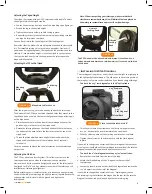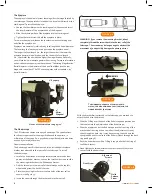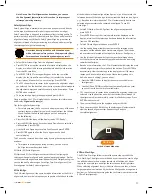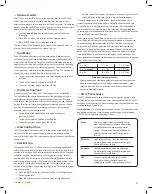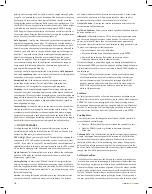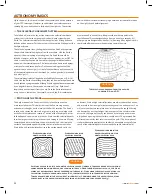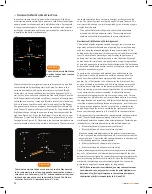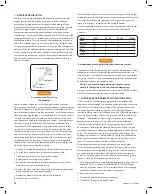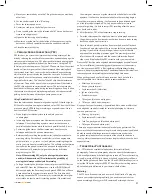
14
>>
www
.celestron
.com
Tracking Rate – In addition to being able to move the telescope with the
hand control buttons, the CPC will continually track a celestial object as it
moves across the night sky . The tracking rate can be changed depending
on what type of object is being observed:
Sidereal
This rate compensates for the rotation of
the Earth by moving the telescope at the same
rate as the rotation of the Earth, but in the
opposite direction . When the telescope is polar
aligned, this can be accomplished by moving
the telescope in right ascension only . When
mounted in Alt-Az mode, the telescope must
make corrections in both R .A . and declination .
Lunar
Used for tracking the Moon when observing the
lunar landscape .
Solar
Used for tracking the Sun when solar observing .
View Time-Site – Displays the current time and longitude/latitude
downloaded from the GPS receiver. It will also display other relevant
time-site information like time zone, daylight saving and local sidereal
time . Local sidereal time (LST) is useful for knowing the right ascension
of celestial objects that are located on the meridian at that time. View
Time-Site will always display the last saved time and location entered
while it is linking with the GPS. Once current information has been
received, it will update the displayed information. If GPS is switched off,
the hand control will only display the last saved time and location .
User Defined Objects – The CPC can store up to 400 different user
defined objects in its memory. The objects can be daytime land
objects or an interesting celestial object that you discover that is not
included in the regular database . There are several ways to save an
object to memory depending on what type of object it is:
Save Sky Object – The CPC stores celestial objects to its database
by saving its right ascension and declination in the sky . This way the
same object can be found each time the telescope is aligned. Once a
desired object is centered in the eyepiece, simply scroll to the “Save
Sky Obj” command and press ENTER . The display will ask you to
enter a number between 1-200 to identify the object. Press ENTER
again to save this object to the database.
Save Land Object – The CPC can also be used as a spotting scope on
terrestrial objects. Fixed land objects can be stored by saving their
altitude and azimuth relative to the location of the telescope at the
time of observing. Since these objects are relative to the location of
the telescope, they are only valid for that exact location . To save land
objects, once again center the desired object in the eyepiece. Scroll
down to the “Save Land Obj” command and press ENTER . The
display will ask you to enter a number between 1-200 to identify the
object. Press ENTER again to save this object to the database.
Save Database (Db) Object – This feature allows you to create your
own custom tour of database objects by allowing you to record the
current position of the telescope and save the name of the object by
selecting it from any one of the database catalogs. These objects then
can be accessed by selecting GoTo Sky Object.
Enter R.A. - Dec – You can also store a specific set of coordinates for
an object just by entering the R.A. and declination for that object.
Scroll to the “Enter RA-DEC” command and press ENTER . The display
will then ask you to enter first the R.A. and then the declination of the
desired object.
GoTo Object – To go to any of the user defined objects stored in the
database, scroll down to either GoTo Sky Obj or GoTo Land Obj and
enter the number of the object you wish to select and press ENTER.
The CPC will automatically retrieve and display the coordinates before
slewing to the object.
To replace the contents of any of the user defined objects, simply save a
new object using one of the existing identification numbers. The CPC will
replace the previous user defined object with the current one.
Get RA/DEC – Displays the right ascension and declination for the
current position of the telescope .
GoTo R.A/ Dec – Allows you to input a specific R.A. and declination and
slew to it .
Identify
Identify Mode will search any of the CPC database catalogs or lists and
display the name and offset distances to the nearest matching objects.
This feature can serve two purposes. First, it can be used to identify
an unknown object in the field of view of your eyepiece. Additionally,
Identify Mode can be used to find other celestial objects that are close to
the objects you are currently observing. For example, if your telescope is
pointed at the brightest star in the constellation Lyra, choosing Identify
and then searching the Named Star catalog will no doubt return the star
Vega as the star you are observing . However, by selecting Identify and
searching by the Named Object or Messier catalogs, the hand control
will let you know that the Ring Nebula (M57) is approximately 6° from
your current position . Searching the Double Star catalog will reveal that
Epsilon Lyrae is only 1° away from Vega. To use the Identify feature:
• Press the MENU button and select the Identify option.
• Use the UP/DOWN scroll keys to select the catalog that you would
like to search .
• Press ENTER to begin the search.
Note: Some of the databases contain thousands of objects, and
can therefore take a minute or two to return the closest object.
Precise GoTo
The CPC has a Precise GoTo function that can assist in finding extremely
faint objects and centering objects closer to the center of the field of
view for astrophotography and CCD imaging . Precise GoTo automatically
searches out the closest bright star to the desired object and asks
the user to carefully center it in the eyepiece . The hand control then
calculates the small difference between its GoTo position and its
centered position. Using this offset, the telescope will then slew to the
desired object with enhanced accuracy. To use Precise GoTo:
1 . Press the MENU button and use the UP/DOWN keys to select
Precise GoTo .
2 . Choose Database to select the object that you want to observe from
any of the database catalogs listed
3 . Choose RA/DEC to enter a set of celestial coordinates that you wish
to slew to .
4. Once the desired object is selected, the hand control will search out
and display the closest bright star to your desired object. Press ENTER
to slew to the bright alignment star .
5 . Use the direction buttons to carefully center the alignment star
in the eyepiece .
Press ENTER to slew to the desired object.
To store a set of coordinates (R .A ./Dec) permanently into the CPC
database, save it as a User Defined Object as described above .
Summary of Contents for 11007
Page 1: ...InstructionManual 11007 11008 11009...
Page 2: ...www celestron com...
Page 40: ...38 www celestron com APPENDIXD MAPSOFTIMEZONES...
Page 41: ...www celestron com 39...
Page 42: ...40 www celestron com APPENDIXE SKYMAPS...
Page 43: ...www celestron com 41...
Page 44: ...42 www celestron com...
Page 45: ...www celestron com 43...
Page 46: ...44 www celestron com...
Page 47: ...www celestron com 45...






